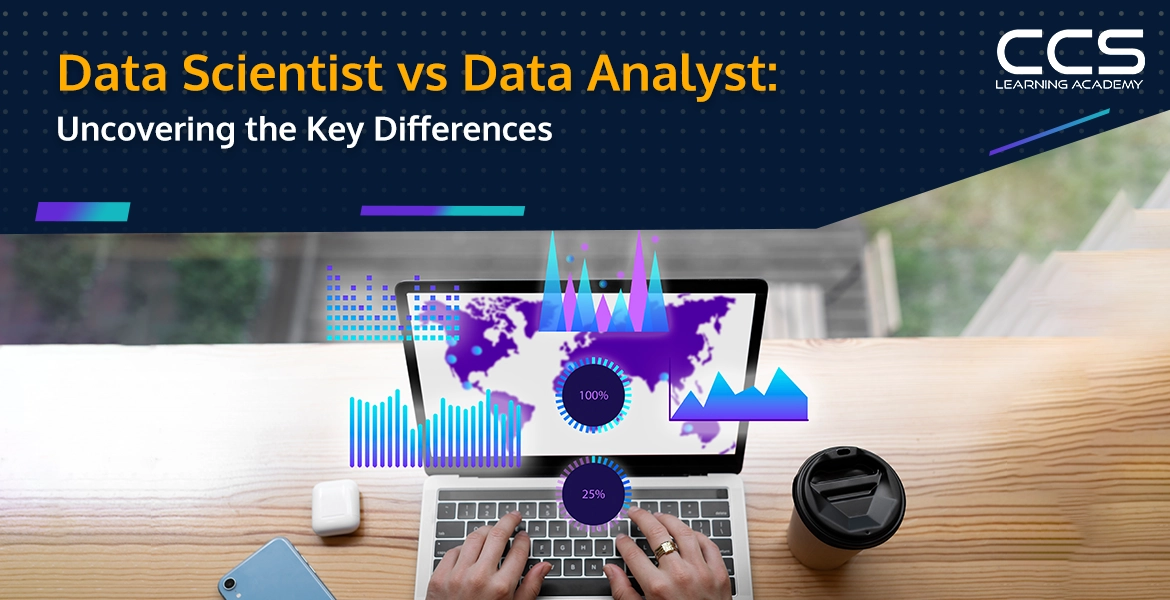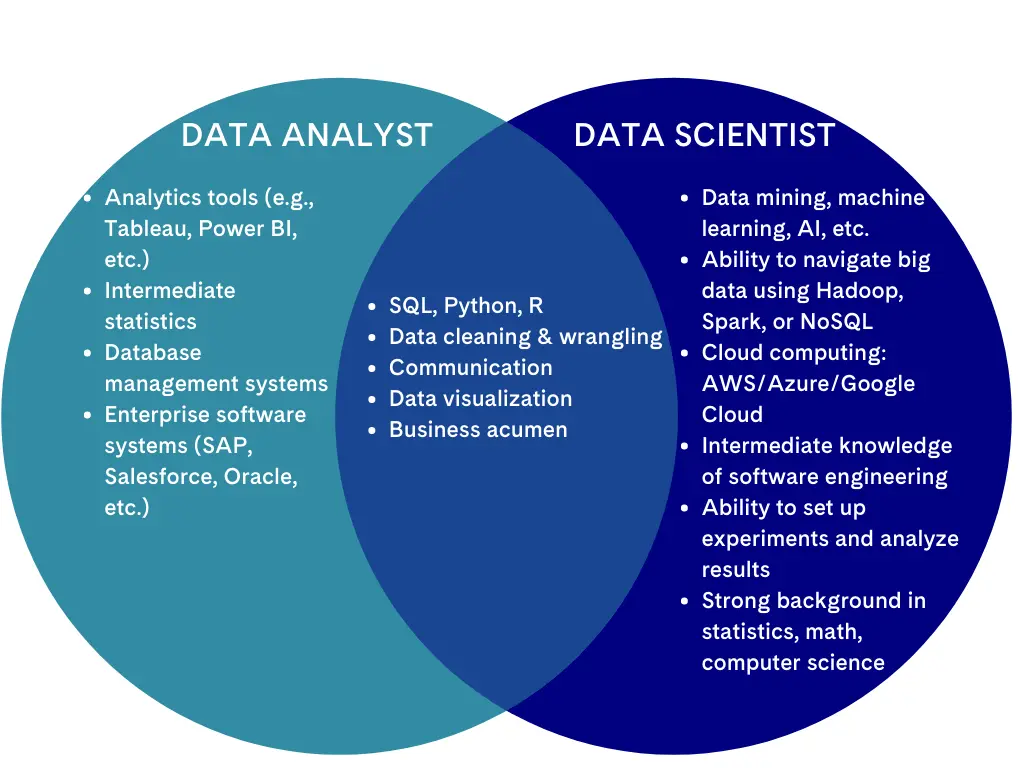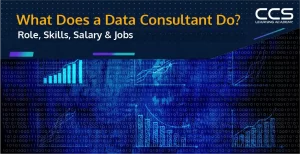Data Scientist vs Data Analyst: Uncovering the Key Differences
- -
- Time -

The data age is upon us, and terms like “data scientist” and “data analyst” are bandied about more and more. But what do these job titles entail, and how do their roles differ? Many look at the explosion of data-related positions and wonder whether they point to overlapping duties or distinctly unique skill sets.
This article will dig into the specifics, comparing and contrasting data scientists and data analysts on crucial fronts. We’ll parse through their day-to-day work, the qualifications they need, their career trajectories and earning potentials, and how their contributions tie back to business objectives.
By clearly mapping out where these roles converge and where they branch apart, readers can come away with an unambiguous understanding of what sets data scientists and data analysts apart. This will prove invaluable for those looking to pursue one of these in-demand careers and make sure they set out on the right foot. It will also give managers keen insight into the specialized talents each role brings to an analytics team.
So whether you’re aspiring to one day tackle machine learning algorithms and statistical models, help teams drill into metrics and paint data-driven pictures, or lead a high-performing group of data experts, read on to learn the key particulars of data scientists versus data analysts. This article will lay everything on the table – from the skills that set them apart right down to their pay grades. Let’s jump in and parse through what makes each position unique!
Table of Contents
- What Does a Data Analyst Do?
- What Does a Data Scientist Do?
- Differences Between Data Analysts and Data Scientists
- Similarities Between Data Analysts and Data Scientists
- Data Analyst vs. Data Scientist Skills
- Data Analyst vs. Data Scientist: Roles and Responsibilities
- Data Scientist Key Responsibilities
- Data Scientist vs Data Analyst: Qualifications
- Data Analyst vs. Data Scientist Salary
- Data Scientist vs Data Analyst: Career Growth
- FAQs
- Q1: What is the primary difference between a Data Scientist and a Data Analyst?
- Q2: What are the typical responsibilities of a Data Scientist?
- Q3: What does a Data Analyst typically do?
- Q4: What kind of technical skills are required for Data Scientists?
- Q5: What technical skills are important for Data Analysts?
- Q6: How do the educational backgrounds for Data Scientists and Data Analysts differ?
- Q7: In what ways do the roles of Data Scientists and Data Analysts overlap?
- Q8: What are the career paths for Data Scientists and Data Analysts?
- Q9: How do the salaries compare between Data Scientists and Data Analysts?
- Q10: What industries commonly employ Data Scientists and Data Analysts?
- Q11: Can a Data Analyst transition to a Data Scientist role?
What Does a Data Analyst Do?
A data analyst plays a crucial role in digging into data to drive business insights. Their core function is to take raw data and transform it into actionable insights that support critical decisions.
On a daily basis, data analysts pore over numbers, trends, and patterns to piece together data puzzles. They spend ample time scrubbing, cleaning, and munging data to prepare it for analysis. A good chunk of their day is devoted to interrogating data sets to spot trends and anomalies. Using various analytical tools, they slice and dice data to analyze performance across multiple dimensions. This allows them to drill down into problem areas at granular levels.
Based on emerging data stories, analysts put together digestible reports, dashboards, and visualizations to call attention to key findings. They also synthesize insights into recommendations to inform strategy changes, process optimizations, and more. In this sense, data analysts act as a bridge between raw technical data outputs and stakeholders who leverage data to advance business objectives.
What Does a Data Scientist Do?
While data analysts focus heavily on retrospective data to uncover insights, data scientists lean more toward predictive modeling and machine learning algorithms to push the business forward. They have a deeper emphasis on statistics and programming over business analysis.
Data scientists heavily prep data to feed, train, and test complex machine learning models. Their goal is to teach systems to independently parse through data, identify patterns, and make accurate predictions. This requires toggling between various tools to shape, transform, and wrangle data to make it model-ready.
Once data is prepped, data scientists try out different algorithmic approaches to engineer the best model. They rigorously fine-tune parameters and hyper-tune models to optimize performance. This process entails a lot of computationally intensive experimentation. It also requires data scientists to equip models to automatically update outputs as new data comes in.
Finally, data scientists translate model outcomes into tangible business recommendations around risk assessments, predictive analytics, forecasting, process automation, and more. They double back frequently to maintain models and ensure sustained accuracy over time.
Differences Between Data Analysts and Data Scientists

A fundamental difference comes down to their orientation around descriptive versus predictive analytics. Data analysts are laser-focused on using past trends to extract powerful descriptive insights about the current state of affairs. Data scientists lean predictive – using modern statistical and machine learning techniques to make forecasts.
Their day-to-day work sees data analysts digging into dashboards, generating various cuts of data, drilling down to find causes behind data outliers, and spotlighting issues areas. Data scientists carry out activities like data wrangling, feature engineering, testing algorithms, and tuning models to output the best predictions.
Skill-wise, data analysts prize business acumen, analysis, math, Excel, SQL, and Tableau – to chop through data and piece together stories and visuals. Data scientists bank heavily on advanced expertise in computer science (Python), statistical modeling, Machine Learning (ML), and AI applications to propel predictive work.
Career trajectory also differs quite a bit. Data analysts usually work their way up from business analyst roles, coming in through a business or data background. Data scientists often enter from more technical domains like computer science or academic research rooted in statistical modeling.
In terms of analytics scope, data analysts take a horizontal approach – analyzing across the breadth of data around a business issue. Data scientists adopt more of a vertical approach – going deep technically to optimize predictive accuracy.
When it comes to team setup and priorities – data analysts support trying to uncover “what happened” to guide decisions. Data scientists enable more of the “what will happen” piece with the models and systems they build. This leads to differentiation in business contributions, too.
The distinctions manifest in compensation as well, with data scientists commanding much higher pay given their highly technical and specialized modeling expertise.
In essence, think of data analysts as providing the powerful rear-view mirror perspective – while data scientists focus more on outfitting businesses with a crystal ball!
Similarities Between Data Analysts and Data Scientists
While their roles diverge on many fronts, data analysts and scientists share quite a bit of common ground that binds their work.
Foremost, they align in prioritizing the crucial preprocessing step of getting raw data ready for review and usage. Both roles spend sizable time cleaning, structuring, mapping out fields, tagging anomalies, and ultimately wrangling data into an analyzable state.
They also overlap when it comes to data visualization and communication. Data scientists may build out complex predictive systems but need to condense model mechanisms and results into digestible snippets that decision-makers can grasp. Data analysts do their own share of boiling down findings into compelling charts, graphs, and dashboards.
Additionally, in many organizations, data analysts and scientists collaborate toward a shared mission of deriving value from data. Analysts leverage their business background to frame the problem and context to feed into the scientist’s models. Scientists then take this domain expertise and bolt it onto their technical modeling to return optimized predictions.
The two roles also often team up on data governance initiatives in databases and data warehouses. Proper data pipelines, schema mapping, and access protocols are imperative for day-to-day workflows. Guiding data storage/ops decisions as a tandem ensures optimal data quality and consistency downstream.
Lastly, while their professional backgrounds and daily tools differ extensively, data analysts and scientists converge on critical soft skills. Namely – curiosity, analytical thinking, problem-solving bent, tenacity to dig relentlessly for answers, and communication chops to contextualize data into compelling insights.
So, in many ways, data analysts and scientists form a powerful symbiotic relationship within data-driven organizations. Their strategic collaboration empowers businesses to thoroughly investigate the past while optimistically predicting the future at the same time!
Data Analyst vs. Data Scientist Skills

When it comes to must-have hard skills, data analysts and scientists fork off quite a bit – even though they start from some shared roots.
Data analysts need to thrive in popular analytics software like Tableau and Excel to be able to slice-and-dice data. Strong SQL skills allow them to dig into and query databases to wrangle, clean, and restructure data for their needs. Proficiency in statistical analysis and data modeling unlocks the ability to scrub data for valuable insights.
Data Scientists bank heavily on top-notch coding abilities – especially Python and R – to ingest, transform, and reshape data to engineer, test and tweak complex machine learning models. They leverage advanced statistics and algorithms to bolster predictiveness. Many data scientists also code up data pipelines to automate the flow of data from warehouses into production systems. Cloud computing skills in platforms like AWS and Azure further enable them to scale systems.
While basic Python or SQL skills often overlap, data scientists tunnel way deeper into these languages to fuse together customizable modeling recipes. The advanced CS ability allows them to piece predictive engines together tailored to evolving business requirements.
Now, zooming out to soft skills – communication, and storytelling are pivotal for either role. But data scientists often go the extra mile to translate intricate model mechanisms into layman’s terms for leadership. Data analysts also cater presentations to stakeholders but have an easier time tying insights directly to business issues, given their domain knowledge.
When it comes to the problem approach, data analysts shine brighter, tying data directly to processes and metrics in focus. Data scientists float more upstream – identifying data gaps that require inventing whole new modeling methods to fill! But surprisingly, collaboration is integral for both, even for the often rogue data scientists! Data increasingly flows enterprise-wide, necessitating that they loop cross-functional partners in.
The savviest organizations actually strategically groom data analysts to funnel upward into data science over time. They incentivize learning advanced skills in statistical modeling and Python to unlock data superpowers!
Data Analyst vs. Data Scientist: Roles and Responsibilities
Here is a detailed overview of typical data analyst versus data scientist roles and responsibilities:
Data Analyst Key Responsibilities
- Query, investigate, and wrangle data using SQL and Excel to shape it for analysis
- Scrub raw data to fix issues, tag anomalies, handle missing values, and transform it into a pristine state
- Analyze trends in sales, website KPIs, and marketing metrics using statistical methods to surface notable shifts
- Run regressions and what-if analyses to quantify relationships between business drivers like pricing, advertising, and revenues
- Forecast future business trajectory through predictive modeling techniques
- Map out data visually using BI tools like Tableau and Power BI, spotlighting trends in digestible dashboards
- Synthesize insights uncovered in data exploration into actionable strategic recommendations
- Communicate findings to managers and front-line teams through presentations, emails, and memos
Data Scientist Key Responsibilities
- Build data pipelines to automatically pipe torrents of enterprise data into consolidated, cleansed repositories
- Dig into mountains of data using Python and R to engineer features optimized for training ML models
- Apply machine learning techniques like regression, neural networks, random forest, etc on prepared data sets
- Rigorously fine-tune model hyperparameters to squash out the best predictive performance
- Quantify accuracy scores over lengthy cross-validations to qualify real-world effectiveness
- Containerize models within streamlined microservices ready for integration into business applications
- Code up customized algorithms where out-of-the-box ML models come up short
- Set up automated model monitoring triggers to detect production anomalies and drifts
- Work closely with software engineering teams to tightly embed predictions within digital products
Data Scientist vs Data Analyst: Qualifications
Here is a detailed overview of the typical qualifications for data analysts versus data scientists:
Data Analyst Qualifications
- Bachelor’s degree in mathematics, analytics, data science, or statistics as a foundation
- Coursework focusing on areas like multivariate calculus, sampling theory, and advanced statistics
- SQL training to gain fluency in querying databases and wrangling big data sets
- Business analysis education to sharpen abilities to frame problems and contextualize data
- Excel and Tableau exposure via analytics modules to acquire visualization aptitude
- Python classes involving data analysis libraries like NumPy, and Pandas, to enable advanced analysis
- Optionally, data warehousing or integrity certificates to tune data modeling/mapping chops
Data Scientist Qualifications
- Minimum – Bachelor’s degree in computer science, programming, or technical field
- Common – Master’s degree concentrating on machine learning and artificial intelligence application
- Extensive coding coursework with a concentration on algorithms, data structures
- Math-intensive training in areas like multivariate calculus and linear algebra
- Statistics degree, including expertise in regression analysis, hypothesis testing
- Proficient across the full stack of ML languages – Python, R, SQL, Hadoop, Spark
- Cloud platform fluency via AWS/Google Cloud certifications to propel scalability
- Ongoing nano-degree credentials to double down on AI sub-domains
A key ladder to climb from analyst into higher-tier data scientist roles involves sharpening proficiency in fierce Python coding and calculus-grounded statistics. While the baseline table stakes differ presently, these upskilling rungs enable analysts to cross over into advanced modeling!
Data Analyst vs. Data Scientist Salary
Data analysts in the earlier years of their careers generally fall in the $60,000 to $90,000 total compensation range. With about 5 years under their belt and some managerial duties, pay can scale up to $100K to $130K as a senior data analyst. Exceptions who dive into executive leadership or highly technical roles do break past $150K.
Data scientists crack past the six-figure mark much earlier on, starting off in the $95K range after graduate school. Mid-career data science leaders and machine learning architects with specialized expertise can rake in anywhere from $130K at the lower end up to $220K+. Owners of rare skill sets like deep learning and NLP tend to land on the higher side. The most senior roles in larger tech companies breach $300K as well.
Data analysis tends to align more with business operations, while data science is tagged as an R&D function. Since data science works on building future capabilities – not just realizing them – their pay scales are higher. Analysts tune into current realities while scientists actively bend them!
The BLS pegs analyst job expansion at 25% over the next 10 years, adding almost 100K positions. For data scientists, holding volume may balloon by a whopping 36% – signaling over 40K open roles. Demand already vastly outweighs supply at the moment.
So, while starting and mid-points vary notably, virtuosic data analysts can still clock serious paychecks on par with ordinary data scientists later on. Especially as sought-after analytical skills become more scarce.
But data scientists race ahead in compensation out of the gates due to specialization in tools like Python, ML algorithms, and AI. These skills pave the way for them to architect and own advancements that create lasting enterprise value. Ultimately, they command higher pay because they actively build the predictive factories that data analysts then leverage!
Data Scientist vs Data Analyst: Career Growth
Here is a detailed overview of the career growth trajectories for data analysts versus data scientists:
Data Analyst Career Progression
Early on, data analysts cut their teeth, creating basic charts and tables while assisting senior-level reporting. As SQL, Excel, and data visualization expertise grow, they take on more complex descriptive analytics and dashboard building. Strong performers get to oversee report automation and guide business decisions, leveraging insights uncovered.
Veteran analysts then bridge into predictive techniques like forecasting models, lending their business context skills to guide and interpret outcomes. Some double click into people management, directing analytics teams and projects. Others architect mature BI systems and practices enterprise-wide.
Common end-goal roles include leading expansive analytics outfits, becoming go-to advisors on steering decision-making through data, or bringing coveted analytics skills into consulting. Evolving tech capabilities like AI and automation stand to amplify the game of stellar analysts even further.
Data Scientist Career Journey
Early data scientists focus intensely on honing coding abilities, statistical methods, and nimble experimentation to build basic predictive models. They cut their teeth on narrow use cases and algorithms guided closely by senior scientists.
Standout performers go on to own the entire model and build lifecycles for accelerating productivity and stripping out risk. Tech scope also expands into specialized domains like computer vision and NLP. Further down, management beckons — coordinating complex modeling projects, nurturing junior talent, and interacting with stakeholders.
Eventually, accomplished data scientists position themselves as chief AI innovators developing breakthrough applications like self-driving vehicle vision, disruptive blockchain fraud detection, or transformative quantum algorithms. They morph into versatile technical celebrities advancing industries!
The most ambitious data scientists may wind up pioneering new roles as “Chief AI Officers” or “Heads of AI Product” – directing model production on par with software engineers and pioneering bets on emerging capabilities.
Conclusion
Pulling all the threads together on data analysts versus data scientists – while crossover exists, distinct focus areas set them apart. Data analysts bring crucial business intuition, while data scientists supply vital technical firepower.
Analysts lean in on investigating past and current trends to guide better decision-making. Scientists emphasize predicting the future through modern AI and ML capabilities. Analysts excel at providing wide visibility across the organization – scientists enable pinpointed recommendations and automated insights.
Yet, as the lines increasingly blur between these two data-driven worlds, having a mixture of complementary skillsets will be invaluable. Especially as enterprises doubtlessly double down on both retrospective and forward-looking data strategies in the years ahead.
For those keen to pursue either path, check out CCS Learning Academy’s Data Analytics and Engineering Bootcamp program. This immersive bootcamp training program accelerates proficiency across the full scope of querying, analyzing, and visualizing data to uncover powerful insights.
So whether you long to be a strategic advisor helping leaders capitalize on organizational knowledge via impactful data stories or desire to be an innovator advancing capabilities through cutting-edge modeling – CCS Learning Academy has you covered! Ready your resume for an in-demand career built atop the exponentially growing foundations of data.
FAQs
Q1: What is the primary difference between a Data Scientist and a Data Analyst?
Answer: The primary difference lies in the scope of their work. Data Scientists typically focus on advanced data processing, including predictive modeling and machine learning, to generate insights and strategies. Data Analysts, on the other hand, focus more on interpreting existing data to identify trends, develop reports, and support decision-making processes.
Q2: What are the typical responsibilities of a Data Scientist?
Answer: A Data Scientist’s responsibilities include designing and implementing models for data analysis, using machine learning to derive predictive insights, developing algorithms to analyze complex datasets, and communicating findings to inform strategic decisions.
Q3: What does a Data Analyst typically do?
Answer: A Data Analyst typically gathers, processes, and performs statistical analysis on existing data. Their work often involves creating visualizations, preparing reports, and identifying trends or patterns to support business decisions.
Q4: What kind of technical skills are required for Data Scientists?
Answer: Data Scientists generally require strong skills in programming languages like Python or R, experience with machine learning algorithms, proficiency in statistical analysis, and knowledge of big data platforms like Hadoop or Spark.
Q5: What technical skills are important for Data Analysts?
Answer: Data Analysts typically need proficiency in SQL, experience with data visualization tools like Tableau or Power BI, a good understanding of statistical analysis, and often some knowledge of programming languages like Python for data manipulation.
Q6: How do the educational backgrounds for Data Scientists and Data Analysts differ?
Answer: Data Scientists often have advanced degrees (Master’s or Ph.D.) in fields like
computer science, statistics, or mathematics, with a focus on data modeling and machine learning. Data Analysts might have bachelor’s degrees in similar fields but with a focus more on data interpretation and reporting rather than advanced modeling.
Q7: In what ways do the roles of Data Scientists and Data Analysts overlap?
Answer: Both roles involve working with data, requiring skills in data collection, processing, and analysis. They both use similar tools for data manipulation and visualization and need to have a strong understanding of data integrity and accuracy.
Q8: What are the career paths for Data Scientists and Data Analysts?
Answer: Data Scientists can advance to senior data science roles, lead analytics teams, or specialize in areas like AI and machine learning. Data Analysts can progress to senior analyst roles, become data analytics managers, or transition into data science with additional training.
Q9: How do the salaries compare between Data Scientists and Data Analysts?
Answer: Generally, Data Scientists command higher salaries due to their advanced technical skills and the complexity of their work. However, salaries for both roles can vary widely based on experience, industry, and geographic location.
Q10: What industries commonly employ Data Scientists and Data Analysts?
Answer: Both roles are employed across various industries, including technology, finance, healthcare, retail, and government. The demand for data-driven insights makes these roles valuable in almost any sector.
Q11: Can a Data Analyst transition to a Data Scientist role?
Answer: Yes, a Data Analyst can transition to a Data Scientist role, often by gaining additional skills in programming, machine learning, and advanced statistical analysis, sometimes through advanced degrees or specialized courses.






